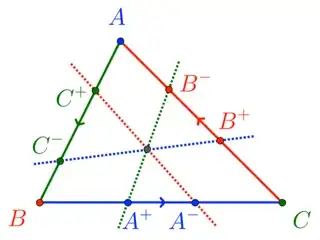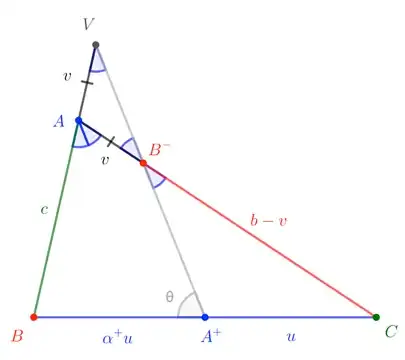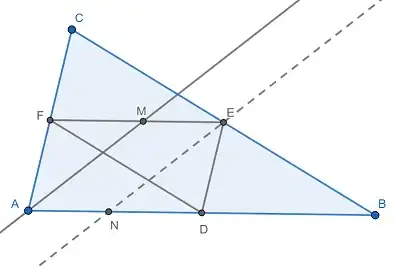I'll exploit a result that I presented in this answer, with different notation:

Extended Ceva's Theorem. Defining ratios of signed lengths,
$$\alpha^+ := \frac{|BA^+|}{|A^+C|} \qquad \beta^+ :=\frac{|CB^+|}{|B^+A|} \qquad \gamma^+ := \frac{|AC^+|}{|C^+B|}$$
$$\alpha^- := \frac{|CA^-|}{|A^-B|} \qquad \beta^- :=\frac{|AB^-|}{|B^-C|} \qquad \gamma^- := \frac{|BC^-|}{|C^-A|}$$
the lines $\overleftrightarrow{A^+B^-}$, $\overleftrightarrow{B^+C^-}$, $\overleftrightarrow{C^+A^-}$ concur iff
$$\alpha^+\beta^+\gamma^+ + \alpha^-\beta^-\gamma^- + \alpha^+\alpha^- + \beta^+\beta^- + \gamma^+\gamma^- \;=\; 1\tag{$\star$} $$
If $A^+$, $B^+$, $C^+$ are midpoints, then $\alpha^+=\beta^+=\gamma^+=1$, and $(\star)$ reduces to
$$\alpha^-\beta^-\gamma^- + \alpha^-+\beta^-+\gamma^- = 0$$
However, we'll find that the angle bisector context makes it natural to express the "$-$" ratios in terms of the "$+$" ones; so I won't invoke the midpoint property prematurely.
Focusing on the angle bisector from $A$ aspect, let $\overleftrightarrow{A^+B^-}$ be parallel to that bisector, and let it meet the extended side $\overline{AB}$ at $V$.

With $u$, $v$, $\theta$ as labeled in the figure, we can use the Law of Sines on $\triangle BA^+V$ and $\triangle CA^+B^-$ to write
$$\frac{\alpha^+ u}{c+v} = \frac{\sin\frac12A}{\sin\theta} = \frac{u}{b-v} \quad\to\quad v = \frac{\alpha^+b-c}{\alpha^++1} \quad\to\quad
\beta^-:=\frac{v}{b-v}=\frac{\alpha^+ b-c}{b+c}$$
Likewise,
$$\gamma^-=\frac{\beta^+ c-a}{c+a} \qquad \alpha^-=\frac{\gamma^+ a-b}{a+b}$$
Substituting into $(\star)$, we can write
$$\frac{(1 + \alpha^+)(1 - \beta^+ \gamma^+)}{a}
+ \frac{(1 + \beta^+ )(1 - \gamma^+\alpha^+)}{b}
+ \frac{(1 + \gamma^+)(1 - \alpha^+\beta^+ )}{c} = 0\tag{$\star\star$}$$
This general condition for concurrence of bisector-parallels through $A^+$, $B^+$, $C^+$ is clearly satisfied when $\alpha^+=\beta^+=\gamma^+=1$ (ie, when $A^+$, $B^+$, $C^+$ are midpoints). $\square$


